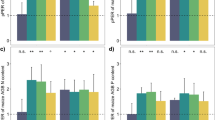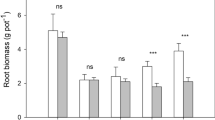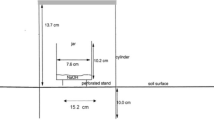Abstract
Little information is available on phosphorus (P) uptake and rhizosphere processes in maize (Zea mays L.), faba bean (Vicia faba L.), and white lupin (Lupinus albus L.) when intercropped or grown alone in acidic soil. We studied P uptake and soil pH, carboxylate concentration, and microbial community structure in the rhizosphere of maize, faba bean, and white lupin in an acidic soil with 0–250 mg P (kg−1 soil) as KH2PO4 (KP) or FePO4 (FeP) with species grown alone or intercropped. All plant species increased the pH compared to unplanted control, particularly faba bean. High KP supply (>100 mg P kg−1) significantly increased carboxylate concentration in the rhizosphere of maize. The carboxylate composition of the rhizosphere soil of maize and white lupin was significantly affected by P form (KP or FeP), whereas, this was not the case for faba bean. In maize, the carboxylate composition of the rhizosphere soil differed significantly between intercropping and monocropping. Yield and P uptake were similar in monocropping and intercropping. Monocropped faba bean had a greater concentration of phospholipid fatty acids in the rhizosphere than that in intercropping. Intercropping changed the microbial community structure in faba bean but not in the other corps. The results show that P supply and P form, as well as intercropping can affect carboxylate concentration and microbial community composition in the rhizosphere, but that the effect is plant species-specific. In contrast to previous studies in alkaline soils, intercropping of maize with legumes did not result in increased maize growth suggesting that the legumes did not increase P availability to maize in this acidic soil.







Similar content being viewed by others
References
Ae N, Arihara J, Okada K (1990) Phosphorus uptake by piegeon pea and its role in cropping systems of the indian subcontinent. Science 248:477–480
Boschetti NG, Quintero CE, Giuffre L (2009) Phosphorus fractions of soils under Lotus corniculatus as affected by different phosphorus fertilizers. Biol Fertil Soils 45:379–384
Cawthray GR (2003) An improved reversed-phase liquidchromatographic method for the analysis of low molecular mass organic acids in plant exudates. J Chrom A 1011:233–240
Cu STT, Hutson J, Schuller KA (2005) Mixed culture of wheat (Triticum aestivum L.) with white lupin (Lupinus albus L.) improves the growth and phosphorus nutrition of the wheat. Plant Soil 272:143–151
De Ridder-Duine AS, Kowalchuk GA, Klein Gunnewiek PJA, Smant W, van Een JA, de Boer W (2005) Rhizosphere bacterial community composition in natural stands of Carex arenaria (sand sedge) is determined by bulk soil community composition. Soil Biol Biochem 37:349–357
Elliott GC, Lynch J, Läuchli A (1984) Influx and efflux of P in roots of intact maize plants. Plant Physiol 76:334–361
Emmert FH (1959) Loss of phosphorus-32 by plant roots after foliar application. Plant Physiol 34:449–454
Fox TR, Comerford NB, McFee WW (1990) Phosphorus and aluminium release from a spodic horizon mediated by organic acids. Soil Sci Soc Am J 54:1763–1767
Frostegård A, Bååth E, Tunlid A (1993) Shifts in the structure of soil microbial communities is limed forests as revealed by phospholipid fatty acid analysis. Soil Biol Biochem 23:723–730
Garbeva P, van Veen JA, van Elsas JD (2004) Microbial diversity in soil: selection of microbial populations by plant and soil type and implication on disease suppressiveness. Ann Rev Phytopath 42:243–270
Garbeva P, van Elsas JD, van Veen JA (2008) Rhizosphere microbial community and its response to plant species and soil history. Plant Soil 302:19–32
Gardner WK, Barber DA, Parbery KG (1983) The acquisition of phosphorus by Lupinus albus L. III. The probable mechanism by which phosphorus movement in the soil/root interface is enhanced. Plant Soil 70:107–124
Gaume A, Mächler F, Leòn CD, Narro L, Frossard E (2001a) Low-P tolerance by maize genotypes: significance of root growth, and organic acids and acid phosphatase root exudation. Plant Soil 228:253–264
Gaume A, Mächler F, Frossard E (2001b) Aluminum resistance in two cultivars of Zea mays L.: root exudation of organic acids and influence of phosphorus nutrition. Plant Soil 234:73–81
Germida JJ, Sicillano SD, Defreitas JR, Seib AM (1998) Diversity of root-associated bacteria associated with field-grown canola (Brassica napus L.) and wheat (Triticum aestivum L.). FEMS Microbiol Ecol 26:43–50
Haynes RJ (1990) Active ion uptake and maintenance of cation-anion balance: a critical examination of their role in regulating rhizosphere pH. Plant Soil 126:247–264
Hinsinger P (2001) Bioavailability of soil inorganic P in the rhizosphere as affected by root-induced chemical changes: a review. Plant Soil 237:173–195
Hinsinger P, Plassard C, Tang C, Jaillard B (2003) Origins of root-mediated pH changes in the rhizosphere and their responses to environmental constraints: a review. Plant Soil 248:43–59
Horst WJ, Waschkies C (1987) Phosphatversorgung von Sommerweizen (Triticum aestivum L.) in Mischkultur mit Weisser Lupine (Lupinus albus L.). Zeitsch Pflanzenern Bdkde 150:1–8
Johnson CM, Ulrich A (1959) Analytical methods for use in plant analysis. Calif Agri Exp Stat Bull 767:25–78
Jones DL (1998) Organic acids in the rhizosphere—a critical review. Plant Soil 205:25–44
Jones DL, Dennis PG, Owen AG, Van Hees PAW (2003) Organic acid behavior in soils—misconceptions and knowledge gaps. Plant Soil 248:31–41
Kamh M, Horst WJ, Amer F, Mostafa H, Maier P (1999) Mobilization of soil and fertilizer phosphate by cover crops. Plant Soil 211:19–27
Kuono K, Tuchiya Y, Ando T (1995) Measurement of soil microbial biomass phosphorus by an anion exchange membrane method. Soil Biol Biochem 27:1353–1357
Li L, Yang SC, Li XL, Zhang FS, Christie P (1999) Interspecific complementary and competitive interaction between intercropped maize and faba bean. Plant Soil 212:105–114
Li L, Sun JH, Zhang FS, Li XL, Rengel Z, Yang SC (2001) Wheat/maize or soybean strip intercropping. I. Yield advantage and interspecific interactions on nutrients. Field Crop Res 71:123–137
Li L, Tang C, Rengel Z, Zhang FS (2003) Chickpea facilitates phosphorus uptake by intercropped wheat from an organic phosphorus source. Plant Soil 248:297–303
Li SM, Li L, Zhang FS, Tang C (2004) Acid phosphatase role in chickpea/maize intercropping. Ann Bot 94:297–303
Li L, Li SM, Sun JH, Zhou LL, Bao XG, Zhang HG, Zhang FS (2007) Diversity enhances agricultural productivity via rhizosphere phosphorus facilitation on phosphorus-deficient soils. Proc Natl Acad Sci 104:11192–11196
Li H, Shen J, Zhang F, Clairotte M, Drevon JJ, Le Cadre E, Hinsinger P (2008) Dynamics of phosphorus fractions in the rhizosphere of common bean (Phaseolus vulgaris L.) and durum wheat (Triticum turgidum durum L.) grown in monocropping and intercropping systems. Plant Soil 312:139–150
Lindsay WL (1979) Chemical equilibria in soils. Wiley, New York, USA 449 p
Liu Y, Mi G, Chen F, Zhang J, Zhang F (2004) Rhizosphere effect and root growth of two maize (Zea mays L.) genotypes with contrasting P efficiency at low P availability. Plant Sci 167:217–223
Marschner P, Baumann K (2003) Changes in bacterial community structure induced by mycorrhizal colonization in split-root maize. Plant Soil 251:279–289
Marschner P, Yang CH, Lieberei R, Crowley DE (2001) Soil and plant specific effects on bacterial community structure in the rhizosphere. Soil Biol Biochem 33:1437–1445
Marschner P, Kandeler E, Marschner B (2003) Structure and function of the soil microbial community in a long-term fertilizer experiment. Soil Biol Biochem 35:453–461
Marschner P, Crowley D, Yang CH (2004) Development of specific rhizosphere bacterial communities in relation to plant species, nutrition and soil type. Plant Soil 261:199–208
McDowell RW, Condron LM, Stewart I (2008) An examination of potential extraction methods to assess plant-available organic phosphorus in soil. Biol Fertil Soils 44:707–715
McKee T, McKee JR (2003) Biochemistry: the molecular of basis of life, 3rd edn. McGraw Hill, New York
Murphy J, Riley JP (1962) A modified single solution method for the determination of phosphate in natural waters. Anal Chim Acta 27:31–36
Nannipieri P, Ascher J, Ceccherini MT, Landi L, Pietramellara G, Renella G, Valori F (2008) Effects of root exudates on microbial diversity and activity in rhizosphere soils. In: Nautiyal CS, Dion P (eds) Molecular mechanisms of plant and microbe coexistence. Springer, Heidelberg, Germany, pp 339–365
Neumann G, Römheld V (1999) Root excretion of carboxylic acids and protons in phosphorus-deficient plants. Plant Soil 211:121–130
Neumann G, Massonneau A, Martinoia E, Römheld V (1999) Physiological adaptations to phosphorus deficiency during proteoid root development in white lupin. Planta 208:373–382
Neumann G, Massonneau A, Langlade N, Dinkelaker B, Hengeler C, Römheld V, Martinoia E (2000) Physiological aspects of cluster root function and development in phosphorus-deficient white lupin (Lupinus albus L.). Ann Bot 85:909–919
Nuruzzaman M, Lambers H, Bolland MDA, Veneklaas EJ (2005a) Phosphorus benefits of different legume crops to subsequent wheat grown in different soils of Western Australia. Plant Soil 271:175–187
Nuruzzaman M, Lambers H, Bolland MDA, Veneklaas EJ (2005b) Phosohous uptake by grain legumes and subsequently grown wheat at different levels of residual phosphorus fertilizer. Aus J Agric Res 56:1041–1047
Osborne L, Rengel Z (2002) Growth and P uptake by wheat genotypes supplied with phytate as only P source. Aus J Agric Res 53:845–850
Pearse SJ, Veneklaas EJ, Cawthray GR, Bolland MDA, Lambers H (2006) Carboxylate release of wheat, canola and 11 grain legume species as affected by phosphorus status. Plant Soil 288:127–139
Pearse SJ, Veneklaas EJ, Cawthray G, Bolland MDA, Lambers H (2007) Carboxylate composition of root exudates does not relate consistently to a crop species’ ability to use phosphorus from aluminium, iron or calcium phosphate sources. New Phytol 173:181–190
Raghothama KG (1999) Phosphate acquisition. Annu Rev Plant Physiol Plant Mol Biol 50:665–693
Richardson AE, Hadobas PA, Hayes JE (2000) Acid phosphomonoesterase and phytase activities of wheat (Triticum aestivum L.) roots and utilization of organic phosphorus substrates by seedlings grown in sterile culture. Plant Cell Environ 23:397–405
Shane MW, Lambers H, Cawthray GR, Kuhn AJ, Schurr U (2008) Impact of phosphorus mineral source (Al-P or Fe-P) and pH on cluster-root formation and carboxylate exudation in Lupinus albus L. Plant Soil 304:169–178
Shen J, Rengel Z, Tang C, Zhang F (2003) Role of phosphorus nutrition in development of cluster roots and release of carboxylates in soil-frown Lupinus albus. Plant Soil 248:199–206
Shen J, Li H, Neumann G, Zhang F (2005) Nutrient uptake, cluster root formation and578 exudation of protons and citrate in Lupinus albus as affected by localized supply of phosphorus in a split-root system. Plant Sci 168:837–845
Song YN, Zhang FS, Marschner P, Fan FL, Gao HM, Bao XG, Sun JH, Li L (2007) Effect of intercropping on crop yield and chemical and microbiological properties in rhizosphere of wheat (Triticum aestivum L.), maize (Zea mays L.), and faba bean (Vicia faba L.). Biol Fertil Soil 43:565–574
Tang C, Yu Q (1999) Impact of chemical composition of legume residues and initial soil pH on pH change of a soil after residue incorporation. Plant Soil 215:29–38
Tang C, Barton L, Rapheal C (1997) Pasture legume species differ in their capacity to acidify a low-buffer soil. Aus J Agric Res 49:53–58
Tang C, Fang RY, Raphael C (1998) Factors affecting soil acidification under legumes. II. Effect of phosphorus supply. Aus J Agric Res 49:557–564
Tang C, Hinsinger P, Jaillard B, Rengel Z, Drevon JJ (2001) Effect of phosphorus deficiency on the growth, symbiotic N2 fixation and proton release by two bean (Phaseolus vulgaris) genotypes. Agronomie 21:683–699
Tang C, Drevon JJ, Jailard B, Souche G, Hinsinger P (2004) Proton release of two genotupes of bean (Phaseolus vulgaris L.) as affected by N nutrition and P deficiency. Plant Soil 260:59–68
Tarafdar JC, Marschner H (1994) Phosphatase activity in the rhizosphere and hyphosphere of VA mycorrhizal wheat supplied with inorganic and organic phosphorus. Soil Biol Biochem 26:387–395
Tong PY (1994) Achievements and perspectives of tillage and cropping systems in China (in Chinese). Crop Sys Cul Tech (Gengzuo Yu Zaipei) 77:1–5
Wang D, Marschner P, Solaiman Z, Rengel Z (2007a) Growth, P uptake and rhizosphere properties of intercropped wheat and chickpea in soil amended with iron phosphate or phytate. Soil Biol Biochem 39:249–256
Wang D, Marschner P, Solaiman Z, Rengel Z (2007b) Belowground interactions between intercropped wheat and Brassicas in acidic and alkaline soils. Soil Biol Biochem 39:961–971
Westerman RL (1990) Soil testing and plant analysis, 3rd edn. American Society of Agronomy and Soil Science Society of America, Madison, Wisconsin
Westover KM, Kennedy AC, Kelley SE (1997) Patterns of rhizosphere microbial community structure associated with co-occurring plant species. J Ecol 85:863–873
Xiao Y, Li L, Zhang F (2004) Effect of root contact on interspecific competition and N transfer between wheat and faba bean using direct and indirect 15N techniques. Plant Soil 262:45–54
Yang CH, Crowley DE (2000) Rhizosphere microbial community structure in relation to root location and plant iron nutritional status. Appl Environ Microbiol 66:345–351
Zhang FS, Li L (2003) Using competitive and facilitative interactions in intercropping system enhance crop productivity and nutrient use efficiency. Plant Soil 248:305–312
Zuo YM, Zhang FS, Li XL, Cao YP (2000) Studies on the improvement in iron nutrition of peanut by intercropping with maize on a calcareous soil. Plant Soil 220:13–25
Acknowledgments
This study was funded by an International Linkage grant from the Australian Research Council and by Major Program of National Natural Science Foundation of China (30890131 and 30890132).
Author information
Authors and Affiliations
Corresponding author
Rights and permissions
About this article
Cite this article
Li, H., Shen, J., Zhang, F. et al. Phosphorus uptake and rhizosphere properties of intercropped and monocropped maize, faba bean, and white lupin in acidic soil. Biol Fertil Soils 46, 79–91 (2010). https://doi.org/10.1007/s00374-009-0411-x
Received:
Revised:
Accepted:
Published:
Issue Date:
DOI: https://doi.org/10.1007/s00374-009-0411-x




